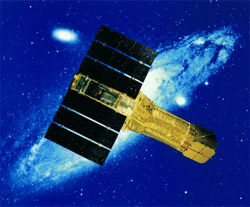The ASCA Mission
(1993-2000)
ASCA (formerly named Astro-D) was Japan's fourth cosmic X-ray
astronomy mission, and the second for which the United States provided part of
the scientific payload. The satellite was successfully launched on
February 20, 1993. Attitude control was lost on
July 14, 2000 during a geomagnetic storm, after which no
scientific observations were performed. ASCA reentered the atmosphere
on March 2, 2001 after more than 8 years in orbit.
The U.S. ASCA Guest Observer Facility (GOF) is located at NASA's Goddard
Space Flight Center in Greenbelt, Maryland. The GOF is part of the Office
of General Investigator Programs
(OGIP) in the Astrophysics Science Division
(ASD).
The primary responsibility of the U.S. ASCA GOF is to enable U.S.
astronomers to make the best use of the ASCA mission, in close
collaboration with the Japanese ASCA team.
|

|
Latest News
|
ADP proposal solicitation is closed for 2006 - watch this space for
future funding opportunity for US-based researchers using the ASCA
archive
More News
|
|
This page is intended for members of the scientific community.
For members of the general public, or those interested in general
astronomy/astrophysics information please go to our
Education and Public Outreach site
or the ASCA results for the
Public section.
|
If you have any questions concerning
ASCA, visit
our
Feedback form.


